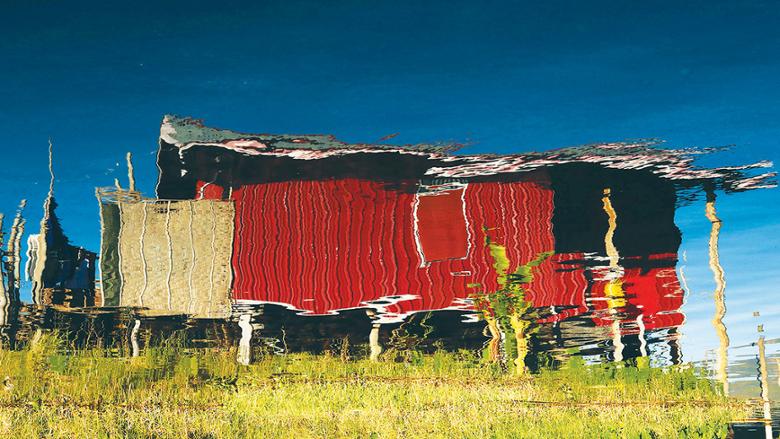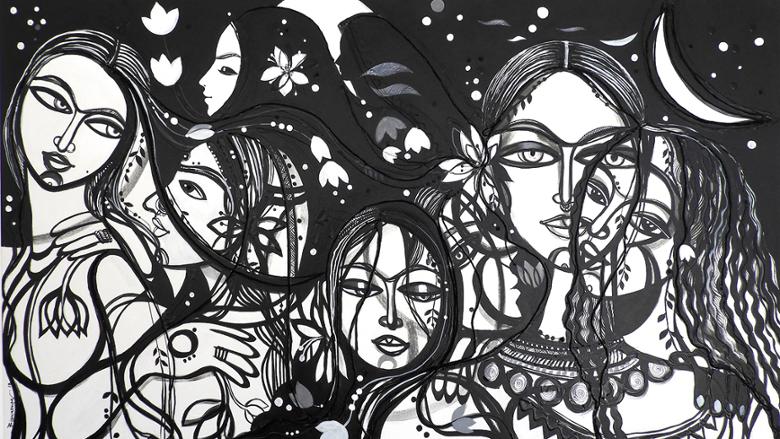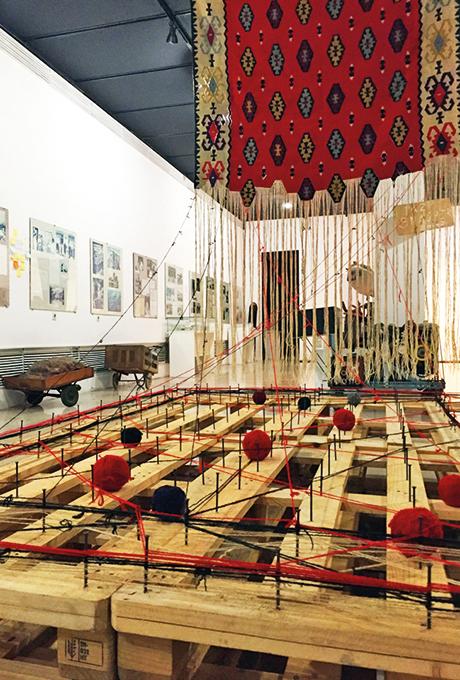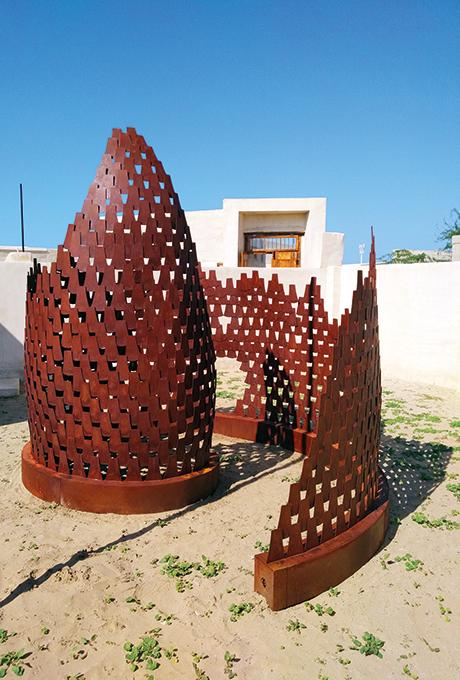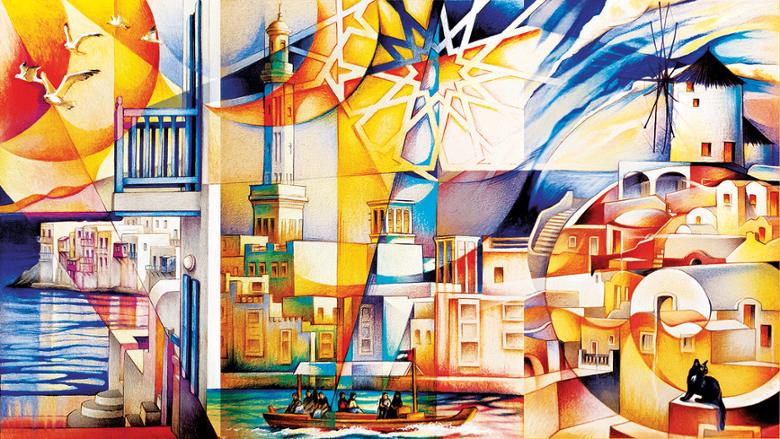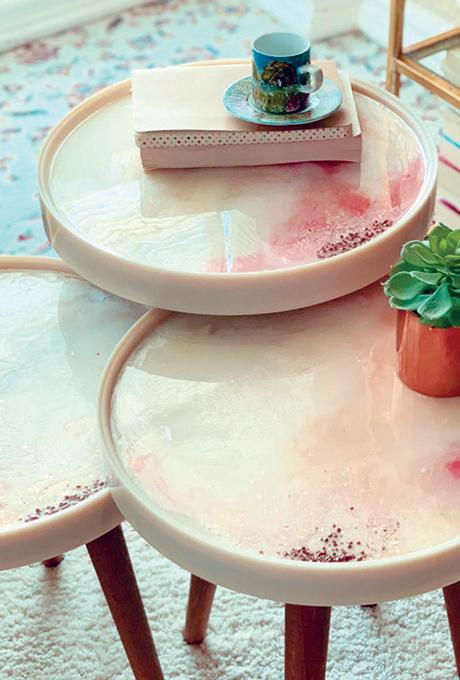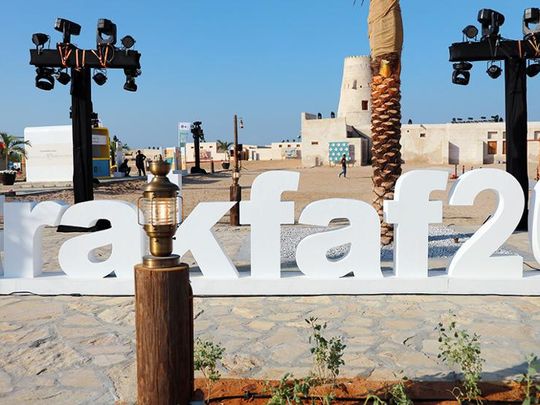
Suspended from the coral stone walls of an ancient watch tower on the edge of a traditional coastal town in Ras Al Khaimah hangs a fabulous installation representing Bosnia’s artistic heritage – a handwoven rug of exquisite form and colour, and a harmonious composition of traditional, repetitive motifs.
Halfway through, the carpet begins to unravel, and its long strands of wool fibres are no longer as vibrant or vivid. It is almost as if all that was once held sacred, the predictability of our lives and cultures, are now tearing down, coming apart in unexpected and unfortunate ways. The frayed, lacklustre wool threads appear wounded, destroyed, and fall limply all the way down.
[Ras Al Khaimah’s abandoned ‘ghost town’ comes alive]
Some coloured strands are connected to a wooden platform in front of the suspended unravelled rug where they find themselves weaving around nails, signalling the (re)construction of a glorious past – but will it ever be the same again?
We are at the Al Jazirah Al Hamra Heritage Village, a 17th century fishing and pearling centre situated on the south-west coast of the emirate of Ras Al Khaimah. Dotted with a variety of compound houses ranging from simple mangrove beam-roofed buildings to ornate houses with courtyards that belonged to rich pearl merchants or traders, the Red Island, as it is more commonly known, was abandoned by its inhabitants in the early 1970s when they moved to the newly formed capital city, Abu Dhabi.
Today, the part of the town that has survived including its fort and traditional coral houses and mosque have largely been restored and forms a spectacular backdrop for the city’s annual Ras Al Khaimah Fine Arts Festival (RAK FAF). Currently in its eighth edition, the RAK Festival is largely seen as a champion of local talent, and serves as a platform for emerging and regional artists, photographers, and filmmakers who represent the community, and enrich our understanding of the world we live in.
This year, the festival celebrates ‘Connected Communities’ as its central theme as it seeks to explore the many ways people build relationships with others, their surrounding environments, and the natural world.
Sarajevo-born Selma Ćatović Hughes’ installation titled ‘Unravelled’ is thus an intimate look into the past, present, and future of her native Bosnia and the lives of its war-trapped citizens in the early 90’s.
‘This project was inspired by my childhood experience of the war in Bosnia,’ explains the artist. ‘Living in Sarajevo under the siege, the unravelling of our lives had its own tempo, mostly beyond one’s control. Celebrating our heritage of carpet weaving, threads become voices of memory.
‘The process of weaving takes time, ritualistic order, repetition and predetermined idea of an outcome,’ she continues. ‘On the contrary, unravelling is undoing everything the long process of weaving had accomplished but at a much faster pace.’
‘Unravelled’ is an art installation expressing the intricacy of the impact that life circumstances have not only on one person, but on an assembly of lives that come together as one whole, adds the artist, a faculty member at the American University of Sharjah.
The 160 artworks from across 34 countries featured at the 2020 edition of the Ras Al Khaimah Fine Arts Festival are built around shared spaces and commonalities, implying the genuine connection amongst communities. ‘Yet, what does community mean to all of us?’ asks Caitrin Mullan, community engagement and outreach director at the Sheikh Saud Bin Saqr Al Qasimi Foundation for Policy Research, which organises the event, as she leads us on a tour through the alleyways, open spaces and into the courtyards and rooms of the villas where the exhibits are displayed.
‘Today, community is no longer just the block down where we live or the people in our immediate vicinity. The world is now smaller, and we live in an increasingly globalised, technology-driven moment in history. The sense of community and its meaning has undergone dramatic changes,’ she explains, saying how through the 2020 theme of ‘Connected Communities’, the Festival hopes to bring to life the many profound ways we experience community and the collective power they have for shaping our small, respective corners of the globe.
The true wealth of humanity – its community, culture and land, form the essence of award-winning photographer Kiliii Yuyan’s work that reveals the hidden stories of indigenous communities in the polar regions, and highlights their subsistence culture.
Kiliii, the honorary guest artist at RAK FAF, is a Nanai (Siberian Native) who explores the human relationship to the natural world from different cultural perspectives and illuminates the importance of viewing conservation through the indigenous lens, explains Caitrin.
Here, at RAK FAF, the visual storyteller turns the spotlight on the Alaskan Iñupiaq community for whom bowhead whaling is an integral element of their cultural identity and a primary source of food. Beautiful images from the real-life situations of an Arctic subsistence culture form the narrative behind his People of the Whale series that gives us an insight into the Iñupiaq lifestyle and culture and their complex relationship with the whales they have hunted in Alaska for the past 2,000 years.
Kiliii also uses the craft of imagery to capture the power and beauty of long-distance sled racers, their dogs and the rugged wilderness of the Alaskan landscape in Women of the Iditarod series. The images on display emphasise the deep bonds and connection the women share with their dogs as they rely on each other – through blizzards, sub-zero temperatures and gale-force winds to compete in the 1,000-miles-long famous Alaskan dogsledding race.
From the fort area housing the Honorary Guest Artist, we move to ‘Bayt 5’ – one of the smaller houses in the heritage village, where three Emirati designers have collaborated and curated a unique visitor experience to highlight universal themes that evoke a sense of shared understanding.

Abu-Dhabi based artist Azza Al-Qubaisi turns to the traditions and heritage of her homeland to create a 900-piece metal sculpture inspired by the date palm. Crafted in steel, the sculpture has a spiral base that references the palm branch’s lines and curves. The metal pieces, welded together in an asymmetrical fashion, reflects changes in life and our connections to each other as people and communities.
Ras Al Khaimah’s Mohammed Al Suwaidi combines his passion for pearling and love of the rich natural resources of his native landscape such as mountain stones and Ghaf wood to create functional pieces of furniture that evoke a touch of modernity and complement the land on which it stands, while conceptual artist Nesa Al Shehhi’s interactive exhibit, ‘Who Am I?’ espouses the theme of tolerance and the values of communal harmony that defines UAE society.
As we walk through the large-scale visual arts and sculpture exhibition, Caitrin informs us that the expanded programme of RAK FAF encompasses films screenings, art workshops, and school education programmes to engage visitors in a wide spectrum of arts and to stimulate conversations on shared experiences that different cultures can relate to. These workshops and talks are held at both Al Jazirah Al Hamra and the National Museum of Ras Al Khaimah while film screenings are held at the VOX Cinemas at Al Hamra Mall.
Propped up on a winding path we discover a splendid homage to Raphael, master of the Italian Renaissance, through an interpretation of his famed fresco, The School of Athens.
The creative brainchild of architecture students Divya Mahadevan, Farah Monib, Gopika Praveen, Nabeela Zeitoun, Tasnim Tinawi, Uthra Varghese, Zahra’a Nasralla and Aashish Rajesh (photographer), the project was a collective effort that brought together a group of around 50, including professors and students, outside the class hours to give final shape and form to their three-year Renaissance recreation project.
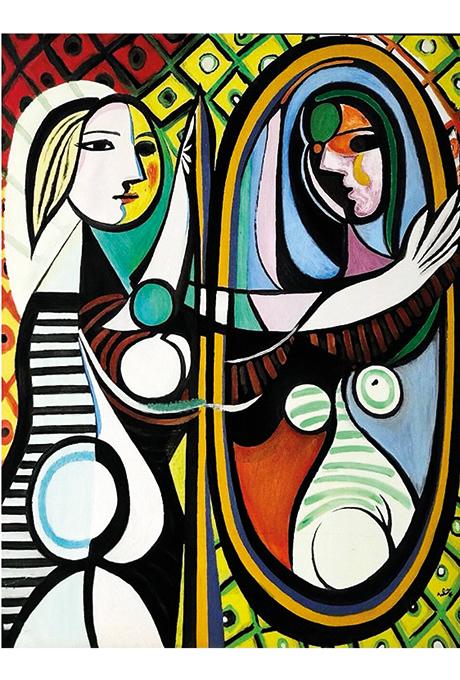
Explaining how the re-enactment of Raphael’s School of Athens came about, Tasnim Tinawi, speaking on behalf of the team, says, ‘With this homage to Raphael, we reconsider the rather limited representation of women and reimagine the conventionally male-dominated ensemble.
‘We found that our process and thinking behind the piece tied in with the ‘Connected Communities’ theme of the festival since it fostered a sense of community between the culturally diverse students, faculty and staff of the American University of Sharjah.’
Yet another work here that has seen the collaboration of many individuals is Noor Aslam’s ‘Sailing in the Same Boat’ that started out as a live painting project in Abu Dhabi on a four-part canvas measuring 4mx1.5m. Reinterpreting the natural shape of the UAE map as a large dhow, Noor docked it out into the sea on his vast canvas, had passengers of many nationalities climb on board with flags in hand, and dotted the coastline with both traditional and modern high rises.

‘Through my work, I wanted to represent how the nation is a living specimen of the qualities of tolerance, pluralism and inclusivity, that are so intricately woven into the very fabric of its society.’
‘During the live painting project, adults, kids and other artists joined in, each one giving their unique touches to the project,” recalls Noor. ‘More than 100 individuals have worked on this artwork, and thus it depicts in its soul and in its execution, the true spirit of the RAK Fine Arts Festival.’
Strategically placed behind a window opening in a large villa, Kuwaiti national Ahmad Al Hussaini’s beautiful wood sculpture titled ‘Embracement’ aptly depicts the safe and secure feeling of being cocooned in the embrace of a parent while Adeline Buenaventura of the Philippines adds a vibrant touch with her Jungle Pop Elephant Collection.
We are also intrigued by Argentinian photographer Andrea Alkalay’s images of stilt-house villages in Myanmar. Emirati photographer Ameena Al Ali also injects a dash of creativity and plays with angles to dramatically improve the composition of common landmarks and places in and around Ras Al Khaimah.
While many artists at RAK FAF have drawn inspiration from people and places around them, Lynn Emery’s passion for wildlife comes alive in her haunting photographs of animals that are today teetering on the brink of extinction. A conservationist at heart, UK-born Lynn says, ‘These photographs are an attempt to draw people’s attention to the importance of conservation.’
Portraits of the rhino, zebra and African elephant leap out from the frames in all their majestic beauty but it is the image of the cheetah that stirs up a flood of emotions for Lynn who recollects observing the animal at the Mugie Conservancy in Kenya. ‘When I first saw Zuri, he was with his brother, Amaka, under the shade of a tree. It was obvious that Amaka was in severe pain owing to a broken hind leg. What struck me most was the humane way in which Zuri took care of his brother, bringing prey he had hunted down, and standing watch over him protectively. It was heartbreaking to see the injured cheetah but the close bond and empathy they shared offered a rare insight into the lives of these magnificent creatures, and is a reminder why their habitats and ecosystems must be protected at all costs.’


